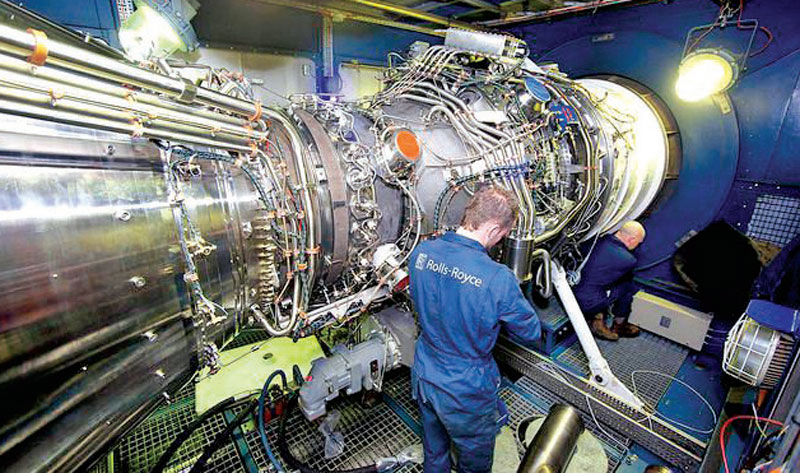Kishore Jayaraman- President, Rolls-Royce India & South Asia
 Rolls-Royce has been in India for several decades. How do you see the role of Rolls-Royce evolving in the future, supporting India’s vision for ‘Atmanirbhar Bharat’?
Rolls-Royce has been in India for several decades. How do you see the role of Rolls-Royce evolving in the future, supporting India’s vision for ‘Atmanirbhar Bharat’?
Rolls-Royce enjoys a strong legacy of decades of partnership with the Indian armed forces. Indeed, Rolls-Royce is the original proponent of the ‘Make in India’ story, demonstrated by transfer of whole engine capability, knowledge and expertise in engine programmes as well as manufacturing partnerships, supporting the country’s vision of self-reliance. Over the past few decades, we have been working consistently with our partners in India to build supply chain capabilities and establish global quality standards with a vision to establish a strong manufacturing ecosystem here.
As India embarks on a path to attain ‘Atmanirbharta’, Rolls-Royce is well-positioned to offer talent, technology and capabilities to co-create solutions locally. We will continue to seek opportunities to co-develop and co-manufacture for the growing aerospace and defence sector with the right Indian strategic partners, paving the way for a stronger ecosystem that can make in India, for India and for the world.
Please elaborate on Rolls-Royce’s partnership with the Indian Navy?
Rolls-Royce has been a strong partner in the mission readiness of India’s defence forces, including the Indian Navy and Coast Guard. With service teams stationed at several locations along India’s coastline, our Power Systems division’s MTU engines power several vessels of both the navy and Coast Guard. We have a partnership with Garden Reach Shipbuilders and Engineers to assemble the MTU Series 4000 engines for naval vessels at the Diesel Engine Plant in Ranchi.
MTU systems today power the largest ships, the strongest tugboats and the biggest land vehicles and provide energy for the world’s most important mission-critical applications. We offer a range of completely integrated hybrid ship propulsion systems under the MTU brand, consisting of internal combustion engines, electric drive modules, transmission systems, batteries, monitoring and control systems, in addition to other electronic components. The hybrid propulsion system offers the flexibility of being able to manoeuvre precisely using the electric motor, or to deliver a powerful bollard pull using the entire power output of the diesel engines and electric motors combined. The combination of diesel engines and electric motors, in addition to batteries will offer our customers significant benefits in a variety of marine applications.
In addition, we are also developing a range of completely integrated hybrid ship propulsion systems under the MTU brand, consisting of internal combustion engines, electric drive modules, transmission systems, batteries, monitoring and control systems, in addition to other electronic components. The hybrid propulsion system offers the flexibility of being able to manoeuvre precisely using the electric motor, or to deliver a powerful bollard pull using the entire power output of the diesel engines and electric motors combined. The combination of diesel engines and electric motors, in addition to batteries will offer our customers significant benefits in a variety of marine applications.
What product offerings does Rolls-Royce have to support the Indian Navy’s modernisation?
We are committed to extending our partnership with the Indian Navy to serve their power needs of today and tomorrow. As India grows to adopt an even more important role on regional and global levels, it is imperative that Indian Navy equips itself to play an increasingly important role in regional maritime security. Choosing the right propulsion system is a crucial decision and it has to be the right decision to ensure a ship will still perform as its systems and capability are upgraded throughout its life. We presented the capabilities of the mighty MT30 marine gas turbine at the DefExpo 2020. Offering a superior power-to-weight ratio, generating up to 43MW from a 30-tonne packaged unit including most of the auxiliary systems, the MT30 is ideally suited to provide next generation capabilities to the Indian Navy’s future fleet.

What gives the Rolls-Royce MT30 an edge over other gas turbines in this segment?
Derived from the Aero Trent engine family, the Rolls-Royce MT30 is the world’s most power dense in-service gas turbine. The MT30 offers excellent power density and reliability that allows the ship to operate anywhere in the world without loss of performance or power, with reduced through-life maintenance. One of the key strengths of MT30 is that it has the power for today and also tomorrow, so effectively helps to futureproof a platform against the future demands for increased electrical power from system upgrades such as weapons and sensors.
Many factors have converged to lead to the success of the MT30 during its first decade, not least its aerospace heritage. It gives navies more power in less machinery space than alternative engine types and offers ship designers much more options and flexibility in designing the naval vessels of tomorrow. The MT30 also supports the ‘lean manning’ concept by virtue of its ultra-low on-board maintenance requirement. Developed as futuristic technology and to meet the growing demand for electrical power, MT30 is operating or has been selected in all conceivable propulsion arrangements across seven ship types—mechanical, hybrid and integrated full electric, with power delivered to water-jets, controllable and fixed-pitch propellers, depending on application.
Chosen to power the US Navy’s Littoral Combat Ship (LCS) USS Freedom more than 12 years ago, the MT30 has become the engine of choice for some of the world’s most advanced naval platforms, including the Royal Navy’s Queen Elizabeth Aircraft Carriers and Type 26 Global Combat Ship plus variants, the US Navy’s Littoral Combat Ship Freedom Class variant and DDG-1000 advanced destroyers, Republic of Korea Navy’s FFX-Batch II frigate, the Japanese Maritime Defence Force’s 30FFM frigate and the Italian Navy’s new Landing Helicopter Dock.

